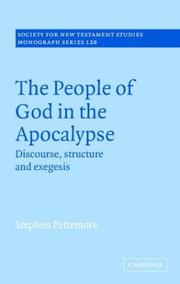| Listing 1 - 1 of 1 |
Sort by
|

ISBN: 0521836980 0521078962 1107150248 051121488X 051121667X 0511315449 0511488157 128054032X 0511211309 0511213077 9780521836982 9780511211300 9780511213076 9780511214882 9780511216671 9780511488153 9781107150249 9780511315442 Year: 2004 Volume: 128 Publisher: Cambridge Cambridge University press
Abstract | Keywords | Export | Availability | Bookmark
 Loading...
Loading...Choose an application
- Reference Manager
- EndNote
- RefWorks (Direct export to RefWorks)
Stephen Pattemore examines passages within Revelation 4:1-22:21 that depict the people of God as actors in the apocalyptic drama and infers what impact these passages would have had on the self-understanding and behaviour of the original audience of the work. He uses Relevance Theory, a development in the linguistic field of pragmatics, to help understand the text against the background of allusion to other texts. Three important images are traced. The picture of the souls under the altar (6:9-11) is found to govern much of the direction of the text with its call to faithful witness and willingness for martyrdom. Even the militant image of a messianic army (7:1-8, 14:1-5) urges the audience in precisely the same direction. Both images combine in the final image of the bride, the culmination of challenge and hope traced briefly in the New Jerusalem visions.
Bible NT. Revelation --- Relevance --- Bible --- Criticism, interpretation, etc --- 228 --- Apocalyps. Boek der Openbaring van Johannes. Apocalyptiek --- Pertinence --- Relevancy --- Bible. --- Abūghālimsīs --- Apocalipse (Book of the New Testament) --- Apocalisse (Book of the New Testament) --- Apocalypse (Book of the New Testament) --- Apocalypse of John --- Apocalypse of St. John --- Apocalypsis Johannis --- Apocalypsis S. Johannis --- Apokalypse (Book of the New Testament) --- Apokalypsin --- Book of Revelation --- Johannes-Apokalypse --- Johannesapokalypse --- Johannesoffenbarung --- Offenbarung des Johannes --- Revelation (Book of the New Testament) --- Revelation of St. John --- Revelation of St. John the Divine --- Revelation to John --- Ruʼyā (Book of the New Testament) --- Sifr al-Ruʼyā --- Yohan kyesirok --- Criticism, interpretation, etc. --- Meaning (Philosophy) --- Meaning (Psychology) --- Arts and Humanities --- Religion --- Relevance. --- Apokalipsa św. Jana --- Apokalipsa świętego Jana --- Criticism, Textual.
| Listing 1 - 1 of 1 |
Sort by
|

 Search
Search Feedback
Feedback About UniCat
About UniCat  Help
Help News
News